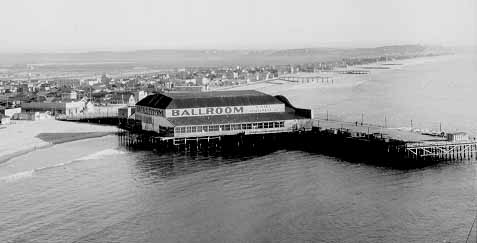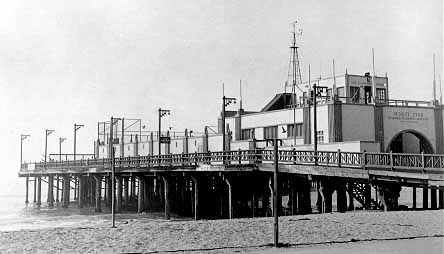Sunset Pier
Revised April 6, 1998
During the period from 1910 to 1925 businessmen announced plans to build rival amusement piers every few years. The Center Street (now North Venice Boulevard) location was desirable because it had a successful business district that served the beach homes in Strong and Dickerson's tract.Eddie Maier, owner of a Los Angeles brewery, announced plans in 1912 to built an amusement pier there in spring 1913. It would be 1300 feet long and 550 feet wide with a 700 car parking lot at its base. The pier would be encircled by a Steeplechase ride and it would feature an open air Swimming Plunge, a Dance Hall, large cafe in the shape of a ship, a carousel, bandstand and Witching Waves. It would also feature a Children's Pavilion of Fun which would be free to children up to age 12.
Work began on the pier in December, 1912 but stopped a week later when Maier had a dispute with William Stutzer, who was the contractor. Stutzer demanded a fee of 20% of the pier cost, and expected to be furnished with all the building materials at no cost. Maier thought his demands were exorbitant and refused. Delays continued through the spring and summer.
What little the owners built of their pier by summer's end was seriously damaged through carelessness when 200 feet of false work fell in the middle of the night in late September. The explosive sound of the pier's dynamo short circuiting as it fell into the sea caused the police to investigate for possible sabotage. By then Maier was fed up with his partner and offered to give the city all of his holdings in his pier company. The Trustees instead called his performance a breach of contract and granted a new franchise to Stutzer to complete the pier at a cost of $75,000. None-the-less, nothing happened and the pier remained a short stub through the teens.
In 1920 the newly incorporated Sunset Pier Company looked like they were finally going to do something with their leasehold on the Center Street Pier. In late September they announced that they were building a horseshoe pier that would extend out 500 feet, then make a 45 degree bend to connect with another pier to be built at Mildred Avenue, a few blocks north. On the south side of the pier would be a replica of an Ocean Liner with all of the amusement features found on the big passenger steam ships. It would have a swimming plunge, bowling alleys, restaurant and cabaret. They were negotiating with C.W. Parker, builder of the Steeple Chase ride at Coney Island to build a duplicate on their pier.
In January 1921, a few weeks after the Abbot Kinney Pier burned in a disastrous fire, Ed Dunnavant's Sunset Amusement Company succeeded in issuing $700,000 in stock for their project. They promoted it as the only pier currently under construction and one without competition. Nearby land values tripled. A $2500 lot on the south beach was suddenly worth $7500.

| The Sunset Pier was built in 1921 a few blocks south of the Venice Amusement Pier at Sunset Avenue (now Venice Boulevard). |
While the Sunset Pier held its grand opening on July 4, 1921 at the same time as Kinney's rebuilt Venice Amusement Pier, they apparently scaled back their plans, or decided to build their pier in stages. The pier did extend out 500 feet and made its 45 degree bend, but the Mildred Street Pier hadn't even been started. The newly built pier featured the Sunset Ballroom on the north side of the pier and a restaurant on the south side. The 26 member "Baby Doll Dance Revue" entertained crowds in its ballroom.
After the Sunset Amusement Company went bankrupt in 1922, the city Trustees leased the pier to Henry Singer for $50,000. They were influenced by personal testimonials made by leading citizens concerning his good character and business acumen. But it became an embarrassment when three days later, Singer was held in a psychiatric ward of the county hospital. He had assaulted Marco Mellman, a banker at Merchant's National Bank in Los Angeles, when he was refused a loan. Investigation revealed that Singer's only asset was his ability to get others to place their confidence in him.
The Sunset Pier was sold for $75,500 to the Electric Pier & Amusement Company in August 1924. The new owners planned to build a new pier with a surface area of 20.5 acres, six acres larger than Coney Island's Luna Park. The pier would accommodate 50,000 to 75,000 people and have an admission price of ten cents (attractions & rides extra). Their company, capitalized at $1.5 million, would build the greatest outdoor swimming pool in the world with a wave making machine. A 75 foot wide sand beach would surround the pool, and in its center would be a huge electric fountain. On the seaward end of the pier would be an open air theater for 20,000 people and two aerial rides. They would also obtain the best amusement park thrill rides for their enormous pier. A contract was awarded in January 1925 and it was to open in June that year. However, the company didn't do much with their holdings and the Sunset Pier closed in 1927.
In September 1926 the Los Angeles Surf Club subleased the pier and presented plans to the city of Los Angeles for a first class club house that would encompass five city blocks of ocean front property adjacent to the pier. A new ballroom with a capacity of 4000 dancers would be built on the pier. This as usual became just another pier project that became financially insolvent.
The city took possession of the Sunset Pier during spring 1929 after the lease was canceled with the Electric Pier Company for non-payment of rent. By that time the pier's superstructure was gone and they only needed to remove the pilings to finish demolition. However, in June the Parks and Recreation Commission decided to build a 64 x 160 foot municipal bathing pavilion on the pier. The pool, costing $20,000, could accommodate 3000 people and would have large sun rooms. Construction began by the end of the year and it opened April 12, 1930.
The Venice Paddle board Club, during the 1930's until the end of World War II used the pier, used the pier's facilities for their clubhouse. The southern half of the surf-line between the Sunset and Venice Piers was reserved for their use. Club members surfed towards shore on 15 - 20 foot long heavy redwood paddle boards.
In 1937 Venice community leaders sent a proposal to the Department of Parks and Recreation to extend the Sunset Pier 973 feet seaward at its same outer 45 degree angle. The 1300 foot long, 80 foot wide fishing pier would have a bait house and two boat landings. The city, which was determined to eventually raze all existing piers when their tidelands leases expired, ignored the proposal.

| Venice's lifeguard headquarters was at the foot of the Sunset Pier. - 1946 |
The beach was widened in 1947 and the Sunset Pier became land-locked. The Brooks Street lifeguard headquarters was closed and moved to the base of the Sunset Pier. It remained there until November 1965 when the lifeguards moved into their new nearby headquarters. The Sunset Pier was then demolished.